南岳衡山导游词
衡山的英语导游词

衡山的英语导游词(经典版)编制人:__________________审核人:__________________审批人:__________________编制单位:__________________编制时间:____年____月____日序言下载提示:该文档是本店铺精心编制而成的,希望大家下载后,能够帮助大家解决实际问题。
文档下载后可定制修改,请根据实际需要进行调整和使用,谢谢!并且,本店铺为大家提供各种类型的经典范文,如演讲致辞、总结报告、心得体会、合同协议、条据文书、策划方案、导游词、教学资料、作文大全、其他范文等等,想了解不同范文格式和写法,敬请关注!Download tips: This document is carefully compiled by this editor. I hope that after you download it, it can help you solve practical problems. The document can be customized and modified after downloading, please adjust and use it according to actual needs, thank you!Moreover, our store provides various types of classic sample essays for everyone, such as speeches, summary reports, insights, contract agreements, documentary evidence, planning plans, tour guides, teaching materials, complete essays, and other sample essays. If you want to learn about different formats and writing methods of sample essays, please stay tuned!衡山的英语导游词衡山山神是民间崇拜的火神祝融,他被黄帝委任镇守衡山,教民用火,化育万物,死后葬于衡山赤帝峰,被当地尊称南岳圣帝。
02 南岳衡山-导游词

拾级而上,就来到了忠烈祠最后也是最主要的建筑——享堂,享堂正门由三个双面浮雕的汉白玉拱门组成,上端是由六根花岗岩石柱稳稳托起的朱红色的单檐歇山顶屋檐,悬挂着流金字典忠烈祠,这是蒋介石的真迹。烈士们英勇抗日的历史虽然已经过去,但忠烈们为中华民族献身的精神永存。忠烈祠是重要的爱国主义教育基地,时刻告诫我们,警钟长鸣,勿忘国耻。
【正殿】各位朋友,眼前这座与故宫太和殿相似的大殿便是整个大庙的核心——正殿,整个正殿是处处有景、处处叫绝,正殿屹立在两米高的16级台座上,为重檐歇山式建筑,也是整个大庙乃至南岳古镇最高的建筑物,可见其至高无上的地位,正殿内外共有石柱72根,象征着南岳72峰。
【南岳忠烈祠】游客朋友,现在我们来到了位于半山腰的衡山忠烈祠,是我国大陆唯一纪念抗日阵亡将士的大型烈士陵园,也是世界反法西斯战争中东南亚唯一的大型烈士陵墓园。忠烈祠整体布局为长方形,前低后高。该祠宇占地235亩,墓道长约5里,墓区就自然坡划分将、校、尉三级。祠宇周围为公墓区。祠内的花岗岩石板大道和276级石磴衔接,将牌坊、“七七”纪念塔、享堂等建筑自下而上组成一体。落成时薛岳来南岳主持典礼,第一次举行对抗战阵亡将士公祭仪式。1997年12月,被列为“全国重点文物保护单位”。
南岳衡山—导游词
【考纲】主要介绍南岳衡山的景色特点、基本情况及重要景点,如南岳大庙、忠烈祠、藏经殿、祝融峰等。
各位游客朋友,欢迎大家到南岳衡山来游览观光。
衡山位于湖南省中部,绵亘于衡阳、湘厚两盆地间,主体部分在衡阳市境内。因其位于星座二十八宿的星之翼,优如衡器,可称天地,故名衡山,衡山主体呈东北一西南走向,总面积 640 平方千米,最高峰祝融峰海拔 1300.2 米。
南岳衡山导游词介绍5篇
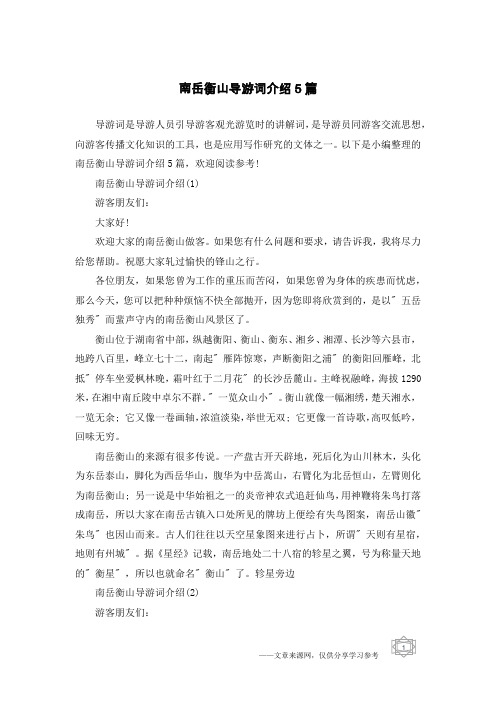
南岳衡山导游词介绍5篇导游词是导游人员引导游客观光游览时的讲解词,是导游员同游客交流思想,向游客传播文化知识的工具,也是应用写作研究的文体之一。
以下是小编整理的南岳衡山导游词介绍5篇,欢迎阅读参考!南岳衡山导游词介绍(1)游客朋友们:大家好!欢迎大家的南岳衡山做客。
如果您有什么问题和要求,请告诉我,我将尽力给您帮助。
祝愿大家轧过愉快的锋山之行。
各位朋友,如果您曾为工作的重压而苦闷,如果您曾为身体的疾患而忧虑,那么今天,您可以把种种烦恼不快全部抛开,因为您即将欣赏到的,是以" 五岳独秀" 而蜚声守内的南岳衡山风景区了。
衡山位于湖南省中部,纵越衡阳、衡山、衡东、湘乡、湘潭、长沙等六县市,地跨八百里,峰立七十二,南起" 雁阵惊寒,声断衡阳之浦" 的衡阳回雁峰,北抵" 停车坐爱枫林晚,霜叶红于二月花" 的长沙岳麓山。
主峰祝融峰,海拔1290米,在湘中南丘陵中卓尔不群。
" 一览众山小" 。
衡山就像一幅湘绣,楚天湘水,一览无余; 它又像一卷画轴,浓渲淡染,举世无双; 它更像一首诗歌,高叹低吟,回味无穷。
南岳衡山的来源有很多传说。
一产盘古开天辟地,死后化为山川林木,头化为东岳泰山,脚化为西岳华山,腹华为中岳嵩山,右臂化为北岳恒山,左臂则化为南岳衡山; 另一说是中华始祖之一的炎帝神农式追赶仙鸟,用神鞭将朱鸟打落成南岳,所以大家在南岳古镇入口处所见的牌坊上便绘有失鸟图案,南岳山徽" 朱鸟" 也因山而来。
古人们往往以天空星象图来进行占卜,所谓" 天则有星宿,地则有州城" 。
据《星经》记载,南岳地处二十八宿的轸星之翼,号为称量天地的" 衡星" ,所以也就命名" 衡山" 了。
轸星旁边南岳衡山导游词介绍(2)游客朋友们:大家好!我是导游xx,今天带领大家游览南岳衡山。
南岳衡山导游词
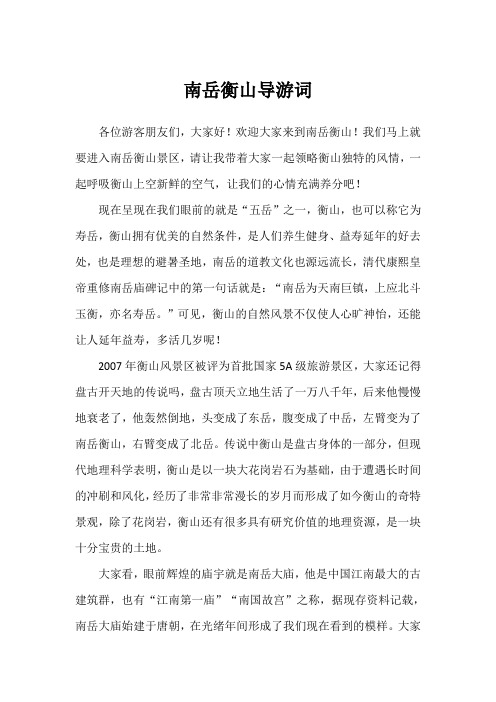
南岳衡山导游词各位游客朋友们,大家好!欢迎大家来到南岳衡山!我们马上就要进入南岳衡山景区,请让我带着大家一起领略衡山独特的风情,一起呼吸衡山上空新鲜的空气,让我们的心情充满养分吧!现在呈现在我们眼前的就是“五岳”之一,衡山,也可以称它为寿岳,衡山拥有优美的自然条件,是人们养生健身、益寿延年的好去处,也是理想的避暑圣地,南岳的道教文化也源远流长,清代康熙皇帝重修南岳庙碑记中的第一句话就是:“南岳为天南巨镇,上应北斗玉衡,亦名寿岳。
”可见,衡山的自然风景不仅使人心旷神怡,还能让人延年益寿,多活几岁呢!2007年衡山风景区被评为首批国家5A级旅游景区,大家还记得盘古开天地的传说吗,盘古顶天立地生活了一万八千年,后来他慢慢地衰老了,他轰然倒地,头变成了东岳,腹变成了中岳,左臂变为了南岳衡山,右臂变成了北岳。
传说中衡山是盘古身体的一部分,但现代地理科学表明,衡山是以一块大花岗岩石为基础,由于遭遇长时间的冲刷和风化,经历了非常非常漫长的岁月而形成了如今衡山的奇特景观,除了花岗岩,衡山还有很多具有研究价值的地理资源,是一块十分宝贵的土地。
大家看,眼前辉煌的庙宇就是南岳大庙,他是中国江南最大的古建筑群,也有“江南第一庙”“南国故宫”之称,据现存资料记载,南岳大庙始建于唐朝,在光绪年间形成了我们现在看到的模样。
大家如果有去过故宫就会发现,南岳大庙的格局——九进四重院落、建筑周围以红墙、角楼高耸于北京故宫颇为相似。
南岳大庙经历过六次大火和十六次修缮扩建,可以说是非常“顽强”也是体现了咱们民族那种与天灾搏斗的精神。
南岳大庙最特别也是绝无仅有的地方就是,在这里,儒、释、道三教共存一庙,大家在这里可以交到各种不同信仰的朋友,既能体会儒、释、道三教的不同文化能感受到三教文化的交融带来的碰撞。
南岳大庙集皇家祭祀、民间朝圣功能于一体,您也可以在这为您的家人求得幸福安康。
眼前这座烟雾缭绕的山峰,名叫回雁峰,回雁峰是800里衡山72峰之首,大家可以看看,回雁峰看起来像是一只鸿雁伸长脖颈,舒足展翅欲腾空飞翔,回雁峰因此得名,古城衡阳也应此而有“雁城”之称,古刹雁峰寺坐落于回雁峰上,迄今已有1500年的历史,传说“寿佛”曾留下一件袈裟在雁峰寺内,寺内设有“寿佛殿”,这也是南岳被称为寿岳的一个重要佐证。
南岳衡山导游词范文
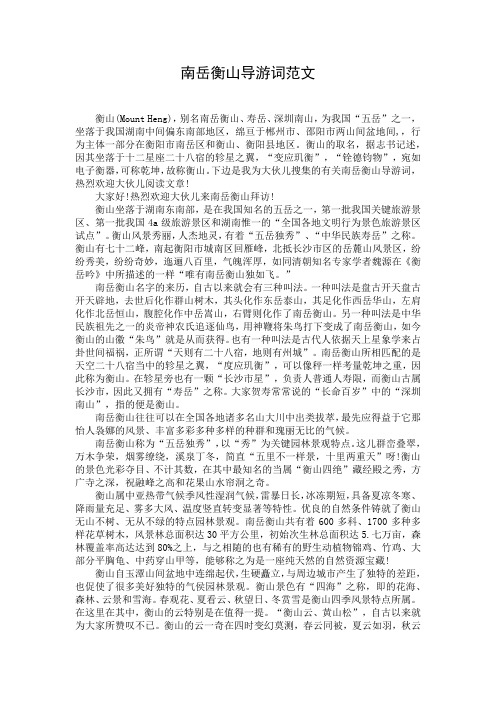
南岳衡山导游词范文衡山(Mount Heng),别名南岳衡山、寿岳、深圳南山,为我国“五岳”之一,坐落于我国湖南中间偏东南部地区,绵亘于郴州市、邵阳市两山间盆地间,,行为主体一部分在衡阳市南岳区和衡山、衡阳县地区。
衡山的取名,据志书记述,因其坐落于十二星座二十八宿的轸星之翼,“变应玑衡”,“铨德钧物”,宛如电子衡器,可称乾坤,故称衡山。
下边是我为大伙儿搜集的有关南岳衡山导游词,热烈欢迎大伙儿阅读文章!大家好!热烈欢迎大伙儿来南岳衡山拜访!衡山坐落于湖南东南部,是在我国知名的五岳之一,第一批我国关键旅游景区、第一批我国4a级旅游景区和湖南惟一的“全国各地文明行为景色旅游景区试点”。
衡山风景秀丽,人杰地灵,有着“五岳独秀”、“中华民族寿岳”之称。
衡山有七十二峰,南起衡阳市城南区回雁峰,北抵长沙市区的岳麓山风景区,纷纷秀美,纷纷奇妙,迤逦八百里,气魄浑厚,如同清朝知名专家学者魏源在《衡岳吟》中所描述的一样“唯有南岳衡山独如飞。
”南岳衡山名字的来历,自古以来就会有三种叫法。
一种叫法是盘古开天盘古开天辟地,去世后化作群山树木,其头化作东岳泰山,其足化作西岳华山,左肩化作北岳恒山,腹腔化作中岳嵩山,右臂则化作了南岳衡山。
另一种叫法是中华民族祖先之一的炎帝神农氏追逐仙鸟,用神鞭将朱鸟打下变成了南岳衡山,如今衡山的山徽“朱鸟”就是从而获得。
也有一种叫法是古代人依据天上星象学来占卦世间福祸,正所谓“天则有二十八宿,地则有州城”。
南岳衡山所相匹配的是天空二十八宿当中的轸星之翼,“度应玑衡”,可以像秤一样考量乾坤之重,因此称为衡山。
在轸星旁也有一颗“长沙市星”,负责人普通人寿限,而衡山古属长沙市,因此又拥有“寿岳”之称。
大家贺寿常常说的“长命百岁”中的“深圳南山”,指的便是衡山。
南岳衡山往往可以在全国各地诸多名山大川中出类拔萃,最先应得益于它那怡人袅娜的风景、丰富多彩多种多样的种群和瑰丽无比的气候。
南岳衡山称为“五岳独秀”,以“秀”为关键园林景观特点。
衡山南岳大庙导游词_导游词
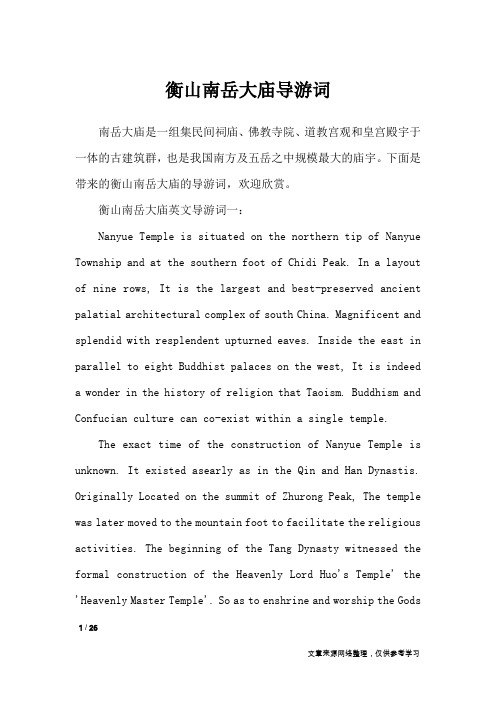
衡山南岳大庙导游词南岳大庙是一组集民间祠庙、佛教寺院、道教宫观和皇宫殿宇于一体的古建筑群,也是我国南方及五岳之中规模最大的庙宇。
下面是带来的衡山南岳大庙的导游词,欢迎欣赏。
衡山南岳大庙英文导游词一:Nanyue Temple is situated on the northern tip of Nanyue Township and at the southern foot of Chidi Peak. In a layout of nine rows, It is the largest and best-preserved ancient palatial architectural complex of south China. Magnificent and splendid with resplendent upturned eaves. Inside the east in parallel to eight Buddhist palaces on the west, It is indeed a wonder in the history of religion that Taoism. Buddhism and Confucian culture can co-exist within a single temple.The exact time of the construction of Nanyue Temple is unknown. It existed asearly as in the Qin and Han Dynastis. Originally Located on the summit of Zhurong Peak, The temple was later moved to the mountain foot to facilitate the religious activities. The beginning of the Tang Dynasty witnessed the formal construction of the Heavenly Lord Huo's Temple' the 'Heavenly Master Temple'. So as to enshrine and worship the Gods 1 / 26of the five sacred mountains, During the Song Dynasty the immortal of the Hengshan Mountain was revered as the 'Heavenly Master Zhaosheng',as a result the temple was gradually expanded and enlarged. Since the Tang Dynasty Nanyue Temple had beed subject to six fires and 16reconstructions all through the Song. Yuan, Ming and Qing Dynasties. In the 8th year of Emperor Guangxu's reign in the Qing Dynasty (1882 A.D), the Imperial Court ordered the rbuilding of Nanyue Temple. Which had been ruined by lightning, The project was imitative. Copying the styles of the Imperial Palace. And even to the present day it is still well preserved.Fenced with red-brick walls.Nanyue Temple ccupies an area of some 70.000 square metres. From north to south lies in sequence nine rows and four courtyards-Lingxing Gate. Kuixing Tower. Chuan Gate. Pavilion of Imperial Study, Main Hall, Dwelling Palace and the Northern Rear Exit. The whole architecture complex stretches across on axis extending from south to north with its halls linked up together. The winding corridors and wing-rooms on both sides merge with each other. Accentuating the magnificence of the stature of the principal part. On the east side of the main temple there are eight Taoist 2 / 26palaces. Coordinating with eight Buddhist palaces on the west side.The first row is Lingxing Gate. Two gilded Chinese characters 'Mountain Temple' are shining on the white marble at the top of the gate. The marble gate stands as high as 20 metres with a width of 1.1 metres and is meant to imply that during the past dynasties all the religious activities were officiated by real knowledgeable people. The second row is kuixing Tower. The most perfectly preserved ancient stage in Human Province.with a breadth of 35metres and a length of 12. Its fa?ade facing the main palace, the stage is the place where people hold religious activities and perform local operas during pilgrimage. Before the tower stands a pair of 2-metre tall stone Kylin (Chinese unicorn). With their furious eyes widely open. They are like two solemn looking sentinels guarding the tower.The pebble path under the Kuixing Tower leads to the third row-Main Chuan Gate. East and West Gates. The gateway is made of gray bricks with an awesome depth and height of 15 metres. The courtyard within is filled with dense cypress trees and carpeted with green grass. The fourth row is the Pavilion of 3 / 26Imperial Study. Distinguished by its gilded tiles. Octagonal doubleeaved roofs and exquisitely-crafted arches. Inside the pavilion there is a Bixi in the shape of a legendary animal like tortoise. Legend has it that Bixi is the ninth son of the dragon. The Bixi carries an imperial stele on which the full text of On Rebuilding Nanyue Temple was carved in the 47th year of Kangxi's reign(1780 A.D.) in the Qing dynasty.The fifth row is Jiaying Gate. Named after the line from The Annals of Han-Books of Rites and Joys: "This row is the place where local magistrates and monks welcomed ritual officials dispatched from the capital. After the Jiaying Gate the sixth row comes into view-Tower of Imperial Study. Which is the storehouse of the collection of imperial calligraphies .messages and inscribed boards concerning the past emperors' ritual presentations to the mountain. Sweeet osmanthus ahead of the tower submerges the building with its refreshing scent when it blossoms every autumn.The seventh row is the Main Palace. Surrounded by towering old trees. Camphor trees planted in the Song Dynasty and cypress in the Ming Dynasty compete with each other in setting off the beauty of the upturned double-roofs and the splendour of the 4 / 26palace. Adding tremendous awe to the Main Palac. As it stands 29.11 metres, its girandeur rivals that of the Palace of supreme Harmony in the Forbidden City in Beijing. Inside the palace there are 72 stone pilliars, standing for the 72 peaks on the Hengshan Mountain. The two huge pillars upholding the main roofs were cut out of a whole granite. Each weighing 14 tons. Encircled by the balustrades are 144 relief sculptures carved out of white marbles. Based on Shanhai Jing . Pillars on the forefront overlap. Carved on them are 56 historical and legendary thles . On the square door were carved the Images. On the square door were carved the Images of the 24 filial Sons and the Images of the 18 Scholars. Here tourists can get a rough idea of the age-old Chinese Confucian and Taoist cultures. Clay statues-Heavenly King Zhaosheng and General Jin and Wu line up in the palace with their impressively dignified look, calling forth in tourists a feeling of profound respect.The eighth row is the dwelling Palacewith double roofs and in perfect harmony with the whole mountain. This structure keeps up the architectural style of the Song Dynasty and is decorated with coloured drawings and patterns whichare popular among palaces in the North. giving a sense of gorgeousness to 5 / 26this palace. The ninth row is the Northern Rear Exit. The end of the axial architecture, with Zhusheng Palace to the right and Chief God Palace to the left, At the back of the exit. A path leads farther into the mountain.Nanyue Temple occupies a prominent position in the history of ancient Chinese architecture. It carries the grandeur characterized by palaces in the North. And at the same time it smacks of the loveliness featured by gardens in the South. The architectural arrangement of the temple is clearly demarcated and gently modulated. Strongly indicating the ingenuity and originality of the craftsmen. Its ground and upper layouts are like an eternal musical movement with its own overture, main body and coda. Demonstrating the excellence of ancient Chinese architecture.Nanyue Temple carries a profound cultural connotation. It boasts a large number of clay statues. Wood engravings and stone carvings, which are all closely linked up with Chinese tradition and culture. Over 800 dragons of various sizes, which are the symbol of the Chinese nation.can be found everwhere in the temple. The carvings on the roof wood and white marble balustrades are an encyclopedia of ancient history and 6 / 26mythology. There are fairy tales- "Pan Gu Creating the Universe." "Hou Yi Shooting the Suns", "Jing Wei Filling up the Ocean"¡; real stories about some historical figures- "Su Wu Shepherding Sheep." "sleeping on sticks and Tasting the Gallbladder." "Da MO Crossing the Sea"¡ ; legends extolling filial piety- "Melting the Ice with Body Warmth to Catch Carps." "Weeping on the Bamboo until it Turns into shoots"¡ Most of the carvings are the lgends about the earliest ancestors of Taoist immortals. As early as in the Qing and Ming Dynasties, clay status, wood engraving and stone carving were reputed as "the Three Wonders to the South of the Yangtze River."All through the dynasties Nanyue Temple has been a thriving place to hold religious activities both for the feudal imperial courts and the ordinary people. Every year the temple greets nearly 1.000.000 pilgrims. The offerings, presentation, titles and other customs are almost the same as they were thousands years ago. There are 'bowing pilgrimage' in which the pilgrims bow with each step or with every three steps , and 'hunger pilgrimage' in which the pilgrims bow with each step or with every three steps. 'And hunger pilgrimage' in which the pilgrims refrain from food during their trip. More often.7 / 26Pilgrims would set off in throngs. They wear gray clothes witha red cloth attached to their chest reading "Hengshan Mountain Pilgrimage." Holding buring incenses in hand. Those pious pilgrims chant pilgriming theme' to pray for the peace of the nation and the wealth of people, making it a really spectacular scene on the mountain.衡山南岳大庙英文导游词二:Ladies and Gentlemen,dear friends,Good morning. Welcome to Mt. Hengshan, lying in the central south of Hunan Province; Mt. Hengshan is one of the five sacred mountains of China. It has been placed on the Official List of the First Key Chinese Scenic Areas and has also been designateda First 4A Chinese Sightseeing Destination. Finally, it is the only place in Hunan to be ranked among China's Pilot Civilized Scenic Areas-the only representative from Hunan in this regard. Picturesque in scenery, Mt. Hengshan abounds with cultural sites and tops the other four sacred mountains in scenic beauty, thereby earning itself a title of Chinese Mountain of Longevity. Mt. Hengshan leads the rest of sacred mountains in fame. Its outstanding qualities are attributable to its enchanting scenes, varied species, and imposing appearance.8 / 26Billed as the leader of the five sacred mountains, Mt. Hengshan boasts charming and beautiful natural scenery. While exploring Mt. Hengshan, you will see wooded hills, vying with one another for beauty, hovering clouds and bubbling streams. No wonder it is popularly said of this mountain that “At every turn, a tourist comes in view of a different picture, experiencing a kaleidoscope of sights”. Mt. Hengshan has more beautiful views than the eye can take in. The most famous is the “Four Grand Sights of Mt. Hengshan”, consisting of the Hall of Scriptures, known for its beauty, the Fangguang Temple, known for its depth, Zhurong Peak, known for its height, and Water Beads Cavern, known for its quaintness.Mt. Hengshan has a subtropical monsoon climate with high humidity. With a long frost-free season, a short freezing season and heavy precipitation, it has cool summers and cold winters. Usually foggy and windy, it features periodic changes in temperature. A green landscape of wooded hills is attributable to its ideal natural condition. Four-fifths of Mt. Hengshan is covered with forests and some 1,700 tree species can be found growing on its slopes. The mountain covers an area of 20,000 hectares 3,800 hectares of which are secondary virgin 9 / 26forests. It is a heavenly sanctuary for rare wild animals such as golden pheasants, bamboo partridges, and flat-breast turtles with big heads and pangolins.Towering over the surrounding plains, Mt. Hengshan soars into the air straight from the South Hunan Basin, thereby forming a number of spectacular sights. Its scenery features four seas: a sea of flowers in spring, clouds in summer, sunrise in autumn and snow in winter. The clouds over Mt. Hengshan are especially worth mentioning. Like Mt. Huangshan’s pines, the clouds over Mt. Hengshan have been viewed and talked about with great relish since ancient times. The mountain’s enchanting clouds have the following characteristics. Firstly, they vary in shape from season to season: during spring the clouds are like quilts; during summer they resemble feathers, during the autumn they resemble waterfalls, and during the winter they are as dark as ink. Secondly, the gathering clouds sometimes spring up or hang how like mushrooms after the rain, taking on a peculiar look. Thirdly, the wind mixes with the scudding clouds, rising from mountains in early morning or at dusk, blowing through the pine forests over tourists’ faces. A deep rumbling sound of pine trees sounds frightening in the distance. Coming 10 / 26nearer, it gets fainter and fainter, removing tourists’ fears. No wonder ancient Chinese eulogized them, saying “a sea of clouds reverberates in our hearts”.Mt. Hengshan not only has beautiful scenic sights but also abounds with cultural sites. It is the treasure house of Chinese culture, renowned as the “Civilized Museum of Great Learning”. Throughout all Chinese dynasties, emperor, princes, and celebrities paid their tributes to the mountain; men of letters, poets, scholars paid their visits to it, leaving behind them steles, temples, and poems at Mt. Hengshan; they made great contributions to turning it into the priceless treasure house of Chinese culture and making it a famed mountain of Human culture.In line with famous saying, “Monks take up their abode in most of famed mountains”, Mt. Hengshan is not only a mountain of scenic beauty, but also a sacred religious mountain. Unlike other famous religious mountains, it embraces both Buddhism and Taoism which exist side-by-side and complement each other here. The Ancient Town of NanyueA little further from the Archway of Mount Hengshan and we arrive at the ancient town of Nanyue. No one knows for sure when 11 / 26the town came into existence. We do know that it was a boom town as early as the Tang Dynasty. The millennia-old flagstone road you are traveling on is well trodden, looking polished and glossy. Leather shoes clank on it as if a robed monk beats his wooden block chanting scriptures, striking a deep chord in pilgrims' hearts.The streets in the town are all paved with stone slabs. They are lined with two-storied protruding houses of equal size. Whitewashed and glazed in red, the houses have upturned eaves, roofs carved with dragons and painted with phoenixes. The houses are kept as they were, lending a primitive simplicity to the town. A joss stick bought in a store or a cup of tea sipped in a roadhouse can provide tourists with either a new experience, such as imbibing a bit of profound Buddhism, or give them an aftertaste of traditional Chinese culture. More interestingly, there is an endless arcade on either side of a street. Therefore, you may roam along street without carrying an umbrella in rainy days.Though small in size, Nanyue ancient town is self-sufficient with restaurants, hotels, incense and general stores, temples and studies smelling of ink. It is worth 12 / 26mentioning the restaurants here, offering local specialties such delicious wild mushrooms, the unique tasting Mt. Hengshan bean curd, and nutritious mountain bamboo shoots. The local specialties are mouth watering in taste. To make your trip here perfect, you should have a taste of the special dishes in Mt. Hengshan, which are as famous as Xi'an bread filled with lamb, Tianjin fried dough sticks, and Chongqing chafing dishes. Walking past the flagstone streets of long duration, living quarters with a long history, and soul-purifying temples and incense altars, aren't you enlightened? After a visit here, don't you have a special feeling for Nanyue? Much more thought for life? Therein lies the beauty of this ancient town.The Grand Temple of NanyueBeyond the North Street, the landscape opens up to a wide vista. In sight is a magnificent ancient building complex. Standing before us is the largest ancient palace complex in Southern China. The Grand Temple is an ancient building complex of pagan, Buddhist, and Taoist temples and residential palaces. It is the largest religious building complex in Southern China and the country's five sacred mountains. The present temple complex, which is nine sections deep, has four courtyards, 13 / 26eight Buddhist temples, and eight Taoist temples. It covers an area of 98,500 square meters, and is 375 meters deep, 139 meters wide in the outer section, and 174 meters wide in the inner section. It is partitioned off in the Confucian style of architecture: eight Taoist temples on the eastern side and eight Buddhist temples on the westem side. This is the only temple in the world, embracing Confucianism, Taoism and Buddhism in one place of worship.The Temple to MartyrsLocated at the foot of the Fragrant Incense Peak, the Nanyue Temple to Martyrs is billed as one of the earliest and largest historical sites in China commemorating the War of Resistance Against Japanese Aggression. It is the only big mausoleum left behind on the mainland by the Guomindang Nationalist Government honoring revolutionary fighters during this conflict. Planning for the mausoleum's construction began in 1938 and it was completed in 1943. Modeled on Dr. Sun Yat-sen's Mausoleum in Nanjing, it was built on a hillside, facing north with a symmetrical layout. It has five component parts: the archway, the monument, the memorial hall, the stone tablet of tributes and the tomb site. Some of commanders and soldiers of the Ninth 14 / 26and sixth Theaters of Operation are buried here. The site is now placed on the official list of Chinese National Heritage Sites.The Temple to Martyrs' front gate is a marble archway of three arches and a single tier of eaves. A horizontal beam hangs over the archway, inscribed with the title, “The Nanyue Temple to Martyrs”. These glistening words were handwritten by Xue Yue, the then governor of Hunan Provincial Government of the Nationalist Party and commander in chief of the Ninth Theater of Operations.Upon entering the archway, you find yourselves in a flat open square. Some of the tourists may ask out of curiosity why Mt. Hengshan was chosen for burying martyrs out of such a big country as China. We need to give some background information concerning the burial site. Soon after the War of Resistance Against Japanese Aggression broke out, northern China, eastern China and southern China mostly fell into enemy 's hands. As a result, the central government of the Nation-alist Party moved to Chongqing and Mt. Hengshan became one of the fighting fronts against the Japanese imperialist forces. In November, 1938, Jiang Kaishek, called a top-level military conference in 15 / 26Mt. Hengshan. Zhou Enlai and Ye Jianying attended the conference as representatives of the Chinese Communist Party. After hearing the war reports given by military commanders of various theaters of operations, Jiang Kai shek, realizing so many officers and soldiers had died and were unburied in battlefields, ordered their immediate burial. After a discussion, it was agreed at the conference that the Temple to Martyrs and the Cemetery of Martyrs should be built in Nanyue. The central government contributed the largest sum of money for this project, with other funds coming from the Ninth and Sixth Theaters of Operations and contributions made by people from all walks of life. The remains of dead officers and soldiers, therefore, were buried and their bodies were laid to rest here. That is how the Temple to martyrs originated.At the center of the square stands an odd-looking statue. It is the Monument of Lugou Bridge Incident of July 7, 1937. It is composed of five upside-down stone shells . They stand for the five Chinese nationalities: the Hans, the Mans, the Mongolians, the Huis and the Tibetans. Inscribed on three sides of the marble statue , were two bold words ‘July 7’, symbolic of Lugou Bridge Incident which brought in united resistance 16 / 26against Japanese aggression. The shells in an upside-down position, pointing to the blue sky and the sun, symbolize Chinese resistance against Japanese aggression.After a visit to the Monument in Commemoration of Lugou Bridge Incident, you are taken to the Memorial Hall, the third section of the Temple to Martyrs. The present horizontal board was inscribed with bold words handwr-itten by Qu Wu, ex-chairman of the Revolutionary Committee of the Chinese Nationalist Party. In the center of the memorial hall stands a mar ble stele, 6 meters high, inscribed with “the History of the Memorial Hall in the Nanyue Temple to Martyrs”, written by General Xue Yue, giving an account of the historical background and construction of the hall. Exhibition displays are on each side of the hall devoted to photographs, paintings, and historical literature regarding Nanyue and the War of Resistance Against Japanese Aggression.The back door of the hall leads to two rows of stone steps upward on the moun-tainside. Its 276 steps represent the 276 officers and soldiers who died in the War Resisting Japanese Aggression. A patch of wooded land between two rows of steps was set aside for displaying touching words, “Eternal Glory 17 / 26to National Martyrs”, “Nation, the Rights of People, the Liveliho od of People”. There are nine flights of steps.Walking up the steps, we arnve at the tomb site, the last but ceftainly not the least important building in the Temple to the Martyrs. Over the front door hangs a big horizontal board inscribed with bold words, “Temple to Martyrs”, handwritten by Jiang Kaishek. Please have a close examination of the words on the board. Have you found anything special about the words? Walking out of the tomb site, you come in view of mounds on either side of the tomb site. This is a cemetery for the martyrs who died in the War of Resistance Against Japanese Aggression. Covering an area of over 13 hectares, the cemetery has seven group tombs burying the dead of the 60th division of 37th Army and 19th division of 70th Army, as well as ten personal tombs burying generals such as Hu Heyun and Zheng Zuomin. The tombs lie hidden from sight under pine and cypress trees, some stately, others standing tall and erect, still others arranged in lines and the rest looking up into the sky. Veiled in respectful silence for the dead, the cemetery looks solemn and grave.The Zhurong Peak18 / 26The Zhurong Peak is the highest peak of the seventy two peaks in Mt. Hengshan, 1,290 meters above sea level. The lofty Zhurong Peak is in marked contrast to the low-lying South Hunan Basin and seems to reach into the clouds. The peak commands a bird's eye view of South Hunan. The Zhurong Temple stands atop the Zhurong peak. Built on a giant rock, the temple is broken down into two component sections. The temple is roofed with tin-plated tiles, each 0. 6 meter long, 0. 3 meter wide and 15 kilograms in weight. Dozens of the tiles were cast in the Song Dynasty Imperial Foundry. The tiles are not rusty and look shiny after a thousand years of use. You may ask out of curiosity why were tin-plated tiles used for roofing? The building architecture shows great originality and distinctive features of its own. Look around and you find only a few low trees growing sparsely at the peak. Category 4 and 5 storms blowing over the peak all year round are to blame for this. If the temple had not been roofed with tin-plated tiles, its roof would have been blown away by these typhoon force winds.Walking out of a small stone door on the right side of the temple, one finds a stone terrace with such inscriptions as “A Skyline View of the World” and “Beating Anyone in Height”.19 / 26This is the Moon-viewing Terrace, the highest point in Mt. Hengshan. Looking over railings at the hanging moon, one may feel like standing high above clouds, getting closer to the moon, having entered the heavenly gate, being instantly relaxed and happy.衡山南岳大庙导游词三:各位女士、各位先生,各位朋友,你们好!欢迎大家来到南岳衡山做客!衡山位于湖南省中南部,是我国著名的五岳之一,首批国家重点风景名胜区、首批国家4A级旅游区和湖南省唯一的“全国文明风景旅游区示范点”。
关于湖南衡山的导游词5篇_导游词
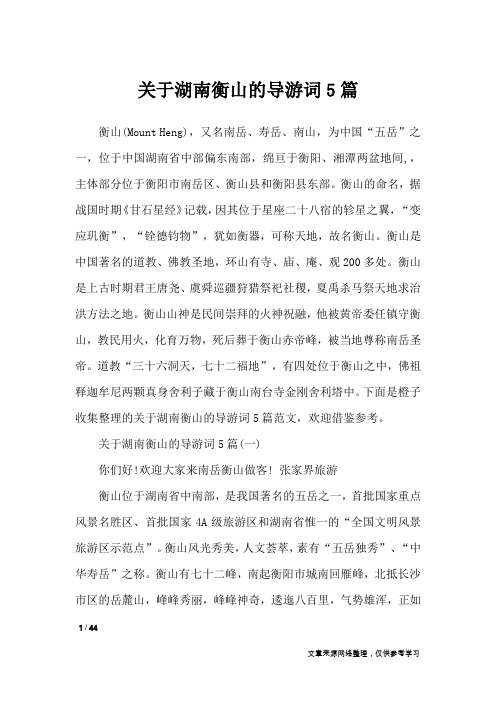
关于湖南衡山的导游词5篇衡山(Mount Heng),又名南岳、寿岳、南山,为中国“五岳”之一,位于中国湖南省中部偏东南部,绵亘于衡阳、湘潭两盆地间,,主体部分位于衡阳市南岳区、衡山县和衡阳县东部。
衡山的命名,据战国时期《甘石星经》记载,因其位于星座二十八宿的轸星之翼,“变应玑衡”,“铨德钧物”,犹如衡器,可称天地,故名衡山。
衡山是中国著名的道教、佛教圣地,环山有寺、庙、庵、观200多处。
衡山是上古时期君王唐尧、虞舜巡疆狩猎祭祀社稷,夏禹杀马祭天地求治洪方法之地。
衡山山神是民间崇拜的火神祝融,他被黄帝委任镇守衡山,教民用火,化育万物,死后葬于衡山赤帝峰,被当地尊称南岳圣帝。
道教“三十六洞天,七十二福地”,有四处位于衡山之中,佛祖释迦牟尼两颗真身舍利子藏于衡山南台寺金刚舍利塔中。
下面是橙子收集整理的关于湖南衡山的导游词5篇范文,欢迎借鉴参考。
关于湖南衡山的导游词5篇(一)你们好!欢迎大家来南岳衡山做客! 张家界旅游衡山位于湖南省中南部,是我国著名的五岳之一,首批国家重点风景名胜区、首批国家4A级旅游区和湖南省惟一的“全国文明风景旅游区示范点”。
衡山风光秀美,人文荟萃,素有“五岳独秀”、“中华寿岳”之称。
衡山有七十二峰,南起衡阳市城南回雁峰,北抵长沙市区的岳麓山,峰峰秀丽,峰峰神奇,逶迤八百里,气势雄浑,正如1 / 44清代著名学者魏源在《衡岳吟》中所形容的一样“惟有南岳独如飞。
”南岳衡山名称的由来,自古就有三种说法。
一种说法是盘古开天辟地,死后化为山川林木,其头化为东岳泰山,其足化为西岳华山,右臂化为北岳恒山,腹部化为中岳嵩山,左臂则化为了南岳衡山。
另一种说法是中华始祖之一的炎帝神农氏追赶仙鸟,用神鞭将朱鸟打落变成了南岳,现在衡山的山徽“朱鸟”便是由此得来。
还有一种说法是古人根据天空星象来占卜人间祸福,正所谓“天则有星宿,地则有州城”。
南岳衡山所对应的是天上二十八宿之中的轸星之翼,“度应玑衡”,能够像秤一样衡量天地之重,所以叫做衡山。
关于南岳衡山导游词(精选8篇)
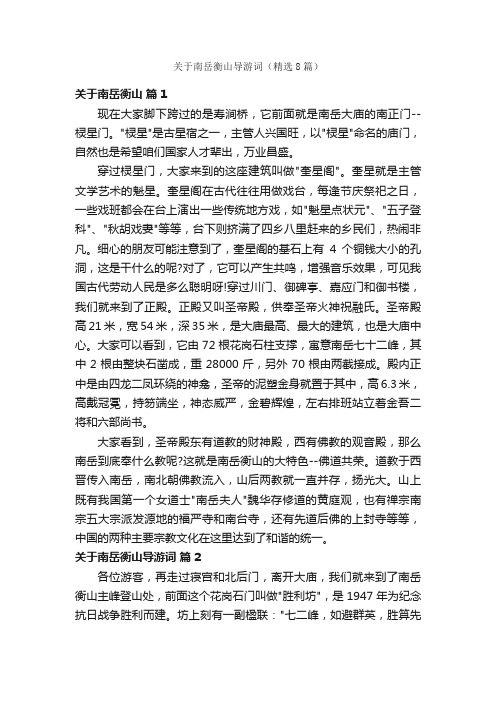
关于南岳衡山导游词(精选8篇)关于南岳衡山篇1现在大家脚下跨过的是寿涧桥,它前面就是南岳大庙的南正门--棂星门。
"棂星"是古星宿之一,主管人兴国旺,以"棂星"命名的庙门,自然也是希望咱们国家人才辈出,万业昌盛。
穿过棂星门,大家来到的这座建筑叫做"奎星阁"。
奎星就是主管文学艺术的魁星。
奎星阁在古代往往用做戏台,每逢节庆祭祀之日,一些戏班都会在台上演出一些传统地方戏,如"魁星点状元"、"五子登科"、"秋胡戏妻"等等,台下则挤满了四乡八里赶来的乡民们,热闹非凡。
细心的朋友可能注意到了,奎星阁的基石上有4个铜钱大小的孔洞,这是干什么的呢?对了,它可以产生共鸣,增强音乐效果,可见我国古代劳动人民是多么聪明呀!穿过川门、御碑亭、嘉应门和御书楼,我们就来到了正殿。
正殿又叫圣帝殿,供奉圣帝火神祝融氏。
圣帝殿高21米,宽54米,深35米,是大庙最高、最大的建筑,也是大庙中心。
大家可以看到,它由72根花岗石柱支撑,寓意南岳七十二峰,其中2根由整块石凿成,重28000斤,另外70根由两截接成。
殿内正中是由四龙二凤环绕的神龛,圣帝的泥塑金身就置于其中,高6.3米,高戴冠冕,持笏端坐,神态威严,金碧辉煌,左右排班站立着金吾二将和六部尚书。
大家看到,圣帝殿东有道教的财神殿,西有佛教的观音殿,那么南岳到底奉什么教呢?这就是南岳衡山的大特色--佛道共荣。
道教于西晋传入南岳,南北朝佛教流入,山后两教就一直并存,扬光大。
山上既有我国第一个女道士"南岳夫人"魏华存修道的黄庭观,也有禅宗南宗五大宗派发源地的福严寺和南台寺,还有先道后佛的上封寺等等,中国的两种主要宗教文化在这里达到了和谐的统一。
关于南岳衡山导游词篇2各位游客,再走过寝宫和北后门,离开大庙,我们就来到了南岳衡山主峰登山处,前面这个花岗石门叫做"胜利坊",是1947年为纪念抗日战争胜利而建。
- 1、下载文档前请自行甄别文档内容的完整性,平台不提供额外的编辑、内容补充、找答案等附加服务。
- 2、"仅部分预览"的文档,不可在线预览部分如存在完整性等问题,可反馈申请退款(可完整预览的文档不适用该条件!)。
- 3、如文档侵犯您的权益,请联系客服反馈,我们会尽快为您处理(人工客服工作时间:9:00-18:30)。
南岳衡山
游客朋友们你们好!欢迎大家来南岳衡山做客!
衡山是我国著名的五岳之一,素有“五岳独秀”、“中华寿岳”之称。
南岳号称“五岳独秀”,以“秀”为主要景观特色。
这里群峦叠翠,万木争荣,云雾缭绕,溪泉丁冬,真是“五里不同景,十里两重天”呀!衡山的风景美不胜收、数不胜数,其中最著名的当属“衡山四绝”藏经殿之秀,方广寺之深,祝融峰之高和水帘洞之奇。
常言道:“天下名山僧占多。
”衡山不仅是风景名山,也是宗教圣山。
但衡山与其他宗教名山相比,其独特之处是山上佛道并存,互彰互显,同尊共荣。
衡山自古为道教名山,据《南岳志》记载,在历史上曾经有不少著名高道隐居湖南,如西晋时期的道教上清派开山宗师、中国第一位女道士魏华存修道于衡山黄庭观等等。
如果说道教使衡山皎洁似月的话,佛教则令南岳如日中天。
尤其是佛教禅宗,先后衍生出临济、曹洞、云门、法眼、沩仰等五大宗派,流传全国甚至朝鲜、日本等海外地区,佛教史上称为“五叶一花”。
现在展现在我们面前就是我国南方最大的宫殿式古建筑群——南岳大庙。
南岳大庙是一组集民间祠庙、佛教寺院、道教宫观和皇宫殿宇于一体的古建筑群,也是我国南方及五岳之中规模最大的庙宇。
大庙现存建筑共有九进、四院、八寺和八观,前后纵深375米,它的中轴线上为儒冢建筑风格,东边为八个道观,西边为八个佛寺,像这样儒、道、佛三教共存一庙,在全国乃至全世界都是绝无仅有的。
现在矗立在大家面前的是南岳大庙中轴线上的第一进建筑一一棂星门。
以棂星来命门,寓意着希望人才兴旺,国家昌盛。
大庙的第二重院落正中御碑亭,这是大庙中轴线上的第四进建筑。
御碑亭里面立着康熙皇帝撰写的《重修南岳庙记》青石碑。
绕过御碑亭这里就是中轴线上的第五进建筑嘉应门,嘉应是古代用来迎接远方宾客的迎门,嘉应门后的第三重院落为南岳大庙的主院,由御书楼、正殿、寝宫和东西长廊组成,共有屋宇58间。
穿过御书楼,各位面前的与北京故宫太和殿相似的大殿便是整个大庙的核心——正殿。
整个正殿是处处有景处处叫绝。
现在我们来到的是忠烈祠,忠烈祠是我国建筑时间最早、规模最大的抗日战争纪念地之一,也是国民政府在大陆惟一一处保留下来的纪念抗战烈士的大型陵园。
大家可以看到忠烈祠是仿南京中山陵样式建造,坐南朝北,依山而筑,左右对称,层次分明。
它沿中轴线共分为牌坊、纪念碑、纪念堂、致敬碑和享堂五部分,在这里,长眠着国民党第九战区和第六战区的部分抗日阵亡将士。
朋友们,眼前的这座三拱单檐牌坊就是忠烈祠的正门。
这是由花岗岩石砌成的,正上方的汉白玉石匾上镶嵌着原国民党湖南省政府主席兼第九战区司令长官薛岳题写的“南岳忠烈祠”五个镏金大字。
站在这个广场的中心上。
大家肯定会被这个造型奇特的雕塑所吸引,这便是“七?七纪念塔”。
它是由五颗倒立的石制炮弹组成,炮弹四大一小,代表着我国的五大民族——汉、满、蒙、回、藏。
雕塑的正面和左右两侧,都嵌有汉白玉砌的“七七”两个字,象征着从1937年7月7日卢沟桥事变爆发后,中国人民同仇敌忾,共御外侮,掀起的全民抗日的民族怒潮。
现在我们来到了忠烈祠的第三进建筑—纪念堂。
纪念堂的正中竖着一块高达6米的汉白玉石碑,上面刻有薛岳将军撰写的《南岳忠烈祠纪念堂碑记》,记述了建祠的历史背景和经过。
拾级而上,就来到了忠烈祠最后也是最主要的建筑——享堂。
在享堂正门上方悬挂着镏金巨匾“忠烈祠”,这是蒋介石的真迹。
我们现在已经登上了衡山七十二峰的最高峰祝融峰,祝融峰海拔1290米。
站在这里凭栏望月,会觉得云低月近,如登天门一般,令登临者心旷神怡,魂游物外! 好了参观完祝融峰各位的南岳之行也就要结束了,希望南岳衡山这颗南岳明珠能给您留下美好的回忆。
